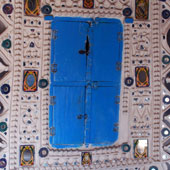According to the elders, mud and mirror work was done directly on the walls of the house using millet husk, mica and clay. Today, the work is done on clay-plastered wooden planks using donkey dung, clay and mirror. The artists do not use any kind of sketch or markings for reference.
The process is as follows:
1. The walls or the board are plastered with clay and the surface is roughened so that the clay sticks to it.
2. Clay is mixed with donkey dung in equal proportions. This mix is then kneaded into dough. The fibers in the donkey dung act as a bonding agent.
3. The wall or the wooden board is moistened with water so that the clay can stick to it.
4. A border is created to define the area inside of which the clay-designs will be made.
5. Small portions of the dough are taken and shaped into cylinders of varying thickness by rolling between the palms or on the floor.
6. The cylinders are then shaped into lines making different patterns while applying slight pressure with the fingers to stick them onto the wall.
7. Mirrors or mica pieces are cut in a variety of shapes and sizes and fixed on top of the wet clay patterns.
8. After the clay dries off in about 4-5 days, a layer of white clay is painted over the artwork.
























